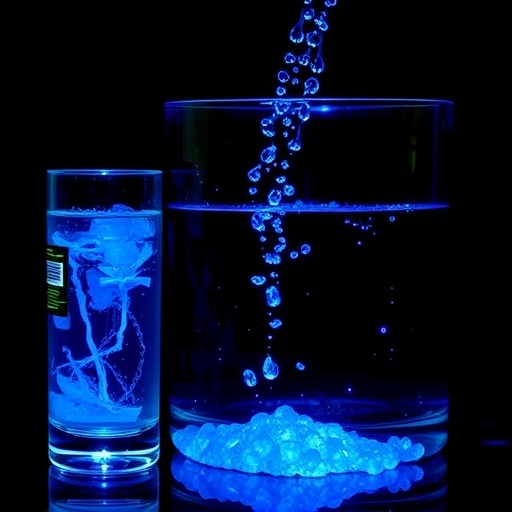The urgent need to address pharmaceutical pollution in aquatic environments has become increasingly evident as our understanding of environmental sustainability grows. Recent research indicates that pharmaceutical pollutants remain in our waters, posing significant risks to both ecosystem health and human safety. The proliferation of these contaminants stems from various sources, including improper disposal practices, industrial discharges, and agricultural runoff that introduces active compounds into our waterways. In this context, the review conducted by Mishra, Visser, and Swart explores the innovative use of barium titanate in conjunction with polymers for the photocatalytic degradation of these pollutants.
Photocatalytic degradation is an emerging technology that utilizes photocatalysts to accelerate the decomposition of pollutants when exposed to light. This technique shows promise in breaking down pharmaceutical compounds that are notoriously persistent in aquatic environments. Barium titanate, a versatile semiconductor material, is known for its photocatalytic properties and its ability to generate reactive species capable of degrading a wide array of organic pollutants, including those from the pharmaceutical sector. When coupled with various polymers, barium titanate can enhance photocatalytic efficacy while potentially improving the stability and reusability of the system.
The review emphasizes the significance of understanding the mechanisms behind photocatalytic processes. Photocatalysis involves light-driven reactions that utilize semiconductor materials to initiate the breakdown of organic contaminants. The interaction of barium titanate with light generates electron-hole pairs, which are highly reactive. These pairs can subsequently interact with water and oxygen to produce hydroxyl radicals and other reactive oxygen species, which are known to effectively degrade pharmaceutical compounds in water bodies. The review systematically examines how the choice of polymers influences the photocatalytic performance of barium titanate, elaborating on essential factors such as surface area, light absorption capacity, and charge separation efficiency.
In addition to discussing the fundamental mechanics, the research highlights various polymers that have been successfully employed in conjunction with barium titanate. For instance, polystyrene, polyvinyl chloride, and polyacrylic acid are noted for their compatibility with the photocatalytic process. The incorporation of these polymers enhances the stability of barium titanate, allowing for prolonged photocatalytic activity while potentially reducing the costs associated with catalyst recovery and reuse. This synergistic approach not only optimizes the degradation efficiency of pharmaceutical pollutants but also creates a more modular and adaptable system for real-world applications.
Field investigations included in the review provide essential insights into the practical applications of this technology. Case studies demonstrate the successful degradation of various pharmaceutical agents, including antibiotics, analgesics, and anti-inflammatory drugs. The results indicate a marked reduction in these compounds’ concentration in treated water samples, showcasing the potential for photocatalytic systems to mitigate the contamination of our aquatic ecosystems. Moreover, the application of barium titanate-based systems is reported to be effective across different light conditions, which is particularly advantageous for real-world implementation in various geographic locations.
As research progresses, the scalability of using barium titanate and polymers in photocatalytic degradation is becoming a focal point of investigation. The transition from laboratory-scale experiments to pilot projects in municipal wastewater treatment facilities will be crucial in determining the technology’s viability as a standard practice. Understanding the cost-effectiveness of large-scale implementations, alongside the ecological benefits, will be key to fostering the widespread adoption of this innovative solution. As highlighted by the authors, collaboration between academia, industry stakeholders, and environmental agencies will be paramount in facilitating the transition from theoretical concepts to practical applications.
Challenges remain, however, particularly regarding the complete mineralization of pharmaceutical pollutants. While significant reductions in concentration can be achieved through photocatalytic processes, ensuring the complete breakdown of these compounds into non-toxic byproducts is vital for the success of this technology. Ongoing research aims to address these challenges by optimizing photocatalytic conditions, such as reactor design and light source selection, to enhance the efficiency and efficacy of the treatment process.
Furthermore, regulatory frameworks surrounding pharmaceutical pollutants are evolving. Policymakers are increasingly recognizing the importance of monitoring and managing these contaminants in aquatic environments. The integration of advanced technologies, such as those explored in the review, into regulation strategies could provide a pathway to more effective environmental stewardship. Collaborating with industries to drive innovation in pollution reduction technologies will be essential in curbing the release of pharmaceuticals into our waterways.
In conclusion, the research conducted by Mishra, Visser, and Swart serves as a crucial step toward understanding and mitigating the impact of pharmaceutical pollutants in aquatic environments. The exploration of photocatalytic degradation using barium titanate in combination with various polymers stands as a promising avenue for addressing this pressing environmental issue. As the field advances, continued emphasis on innovation, collaboration, and practical implementation will be vital to promote ecological health and sustainability.
By integrating insights from both scientific literature and practical applications, this research sheds light on a transformative approach to combating pharmaceutical pollution. It reinforces the notion that interdisciplinary efforts can yield significant advancements in environmental technology. Stakeholders are encouraged to engage with ongoing studies and consider the implications for future research, policy, and practice in the realm of pollutant degradation.
Ultimately, it is through such innovative solutions that we hope to preserve the integrity of our aquatic ecosystems and protect human health from the threats posed by pharmaceutical pollutants. The path forward is clear, and the commitment to fostering research in this arena will be paramount as we seek to navigate the complexities of environmental sustainability.
Subject of Research: Pharmaceutical pollutants and their removal by photocatalytic degradation in aquatic environments.
Article Title: Pharmaceutical pollutants, their occurrence, and removal by photocatalytic degradation in aquatic environments using barium titanate in combination with various polymers: a review.
Article References:
Mishra, P., Visser, H.G. & Swart, H.C. Pharmaceutical pollutants, their occurrence, and removal by photocatalytic degradation in aquatic environments using barium titanate in combination with various polymers: a review.
Environ Sci Pollut Res (2025). https://doi.org/10.1007/s11356-025-37159-9
Image Credits: AI Generated
DOI: https://doi.org/10.1007/s11356-025-37159-9
Keywords: Pharmaceutical pollution, photocatalytic degradation, barium titanate, aquatic environments, environmental sustainability.




